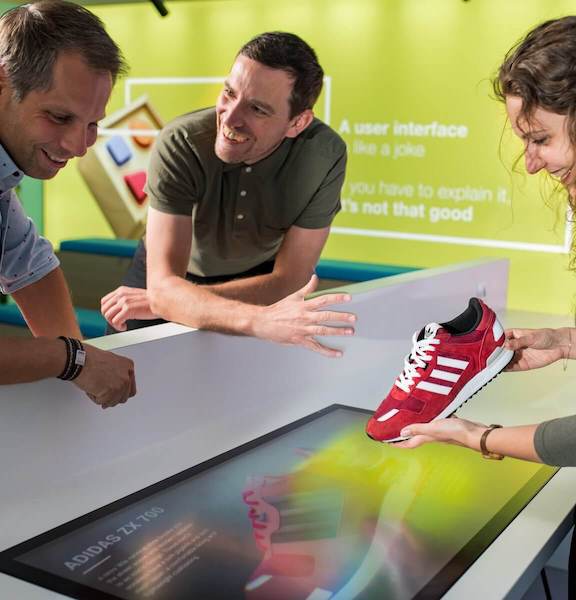No more business as usual. In recent years, immersive
and connected digital experiences
were among the fastest growing segments of our digital economy. Experiences that bridged the digital and
physical, the online and the tangible, were the pillars of countless marketing campaigns, retail overhauls, and
event industries.
Now, in the middle of a global health crisis, where close personal interactions are a risk, even
physical
and tangible interactions can be perceived as liabilities. For our customers and our business, we must
rethink the way we interact in public and retail spaces.
Valtech's research is showing that customers will
approach public interactive systems with more caution
when returning to stores.
- 85% of people will likely head back to stores soon after restrictions are lifted; however, most will
only return to stores with reservations and other precautions that ensure social distancing.
- 45% of people will likely not be willing to touch a digital screen in a public place following the
pandemic, which means we are at risk of losing almost half of our users right at the onset of our
experiences.
-
The results show that fewer women than men will be willing to touch a shared-use digital screen in
public.
How do we avoid personal interactions and physical touchpoints in retail, theme parks, and other physical
venues? We can build upon or replace
existing touchscreen experiences with a suite of touchless interactions to create engaging
experiences — at
a safe distance. Jump straight to the live demos!
In addition to innovative technologies like voice control or gestural control, we might have another
solution in our pockets. Our smartphones can become a universal remote for digital/physical contexts, a
private touchscreen that avoids the risks of shared surfaces.
- It's an interaction customers know. Customers worldwide already use their phones to make
contactless
payments 1, 2, 3 and to order and pay
ahead for curbside pickup or drive-thru.4, 5
- Decades of research back it up. Designers and researchers have long talked about letting existing
computers "annex" personal devices for input and output 6, and modern
technologies can mitigate the
security and privacy concerns.
- Retailers are already starting to explore it. Some retailers and cultural institutions are
already
rolling out new ways to use phones to control and enhance their existing physical experiences.7, 8, 9
- Your customers will prefer it. Valtech's own customer research has indicated that using a
personal phone
as a controller ranks higher than voice control and gesture control in overall level of satisfaction
(7.8/10), ease of adoption (92% said easy or very easy to learn how to use), and level of comfort with
using in a public space (7.8/10).
Valtech knows connected experiences. This site collects our growing list of prototypes
for
low-touch and touchless physical experiences that combine gestural interactions, voice commands, and connected
personal smartphones.
Each use case for a touchless experience brings its own advantages and challenges. In retail spaces, for
example, high foot traffic demands touchless solutions that distinguish between a user's hands and those of a
bystander. In a museum setting, touchless experiences must be robust and adaptable enough to work in dark or
unusual lighting conditions.
Our approaches here are cross-platform and use off-the shelf technologies, so you can test them yourself with
your computer's camera or your smartphone.
Please note that the live video feed in these demos is run locally and is completely private.
Touchless is open source. In the spirit of collaboration, we are share our knowledge and research with
the public to continue building further innovation.
Fork our repo and build your own touchless prototypes here:
https://github.com/valtech-sd/touchless/
Please note that the live video feed in these demos is run locally and is completely private.
